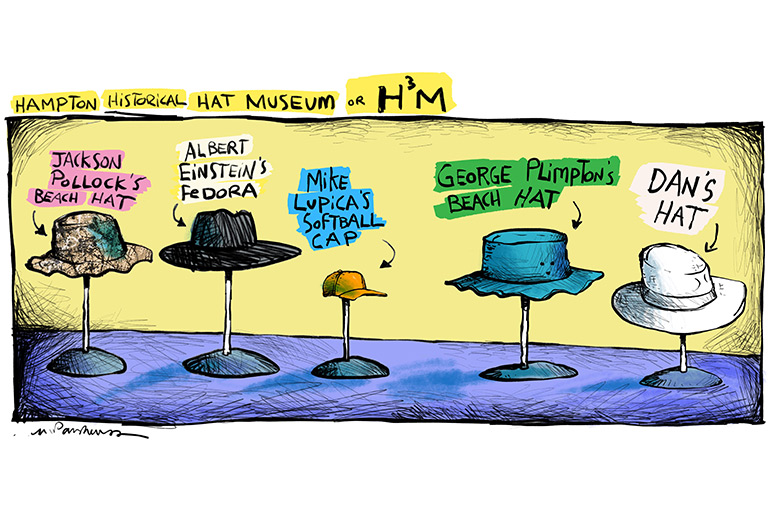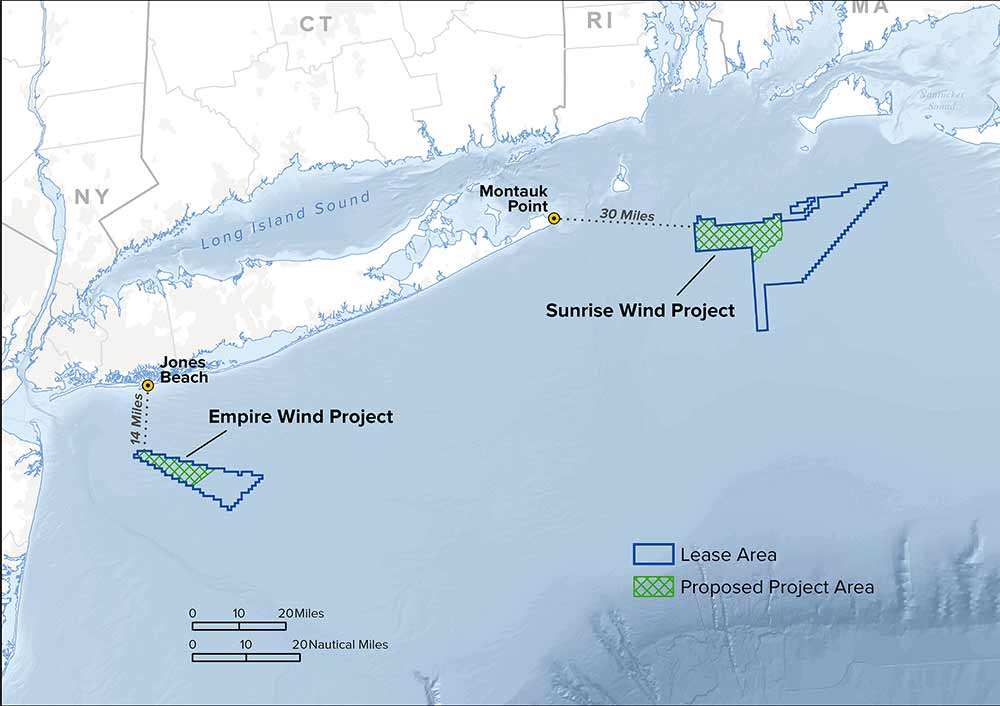My Favorite Things: Dan Shares 25 of His Top Hamptons Spots

I have been asked, using my vast experience from the past 60 years with Dan’s Papers, to give you my very favorite things to see out here. Don’t tell anybody about any of them. This is just for you.
Find more entries in a variety of 2019 Summer Superlatives categories here.
MONTAUK POINT OCEAN BEACH
Frankly I am just so bored with the stunningly beautiful beaches you can lie on extending from Montauk all the way to Westhampton Beach and beyond. Much more interesting to me, anyway, is the ocean beach southwest of the lighthouse. It is consistently rated as the worst beach in the Hamptons. Huge boulders impede your way. Where there are no boulders, good sized rocks make it impossible to lie down. At the back of the beach is an 80-foot-tall sand and dirt cliff, not only impossible to directly climb, but also, creating considerable danger, the location for frequent avalanches. Meanwhile, just off shore there are dangerous giant rocks upon which bask harp seals for most of the year. They are cute, but they bite. Not for the timid.
TOWN LINE BOUNDARY
Here’s a wonderful place for a jog on a sunny Sunday morning. It’s the two-mile-long white line that marks the boundary between East Hampton and Southampton. Get onto that white line at its starting point, where the appropriately named Town Line Road meets the Montauk Highway in Sagaponack. Do a few stretches. Watch out for the cars going up and down the road on either side of you. Then head off for the beach two miles away, where the road ends. If you accidentally step off the white line to the west, you are in Southampton; if you step off the white line to the east, you are in East Hampton.

FIRST CELL TOWER
The first cellphone tower in the Hampton is at the corner of Abraham’s Path and Springs Fireplace Road. It was built for the old and now defunct Sammons TV Cable service in 1978. It’s been made higher since then. Today it rises a majestic 176 feet.
JACKSON POLLOCK CAR CRASH SITE
If the cell phone tower is on the northwest corner where Abrahams and Springs Fireplace meet, directly across the street on the southeast corner is where Jackson Pollock, the famous abstract-expressionist painter, died. He was drunk and driving to a party at Alfonso Ossorio’s house with two beautiful young ladies when he decided he really didn’t want to go, and so turned around about a mile from this spot, came back up Springs Fireplace Road, getting angrier and angrier as the girls chattered about really wanting to go and why was he doing this, and so he stepped on the accelerator, didn’t make the curve there and skidded off the road to slam into a tree. Pollock and one of the women died. The other lived to tell the tale and wrote a book about how Pollock was planning to divorce his wife and marry her. The accident was in 1956, the book about the supposed marriage proposal following a few years later. It’s all overgrown now.

MONTAUK’S SEVEN-STORY BUILDING
Tall and narrow, this odd building rises seven stories in a field facing the downtown plaza. Today it is an apartment house, but originally, when it was built in 1927, it was intended to be an office tower, the first among many that would become the resort city of Montauk. The building was constructed by developer Carl Fisher, who also created the plaza and the whole network of roads downtown, and at the top is the penthouse where he lived when in Montauk with his bride who it was rumored was 15 years old when they got married. This it turned out was not true. His wife, Jane, wrote a book about Carl Fisher after the development failed and he passed away in 1939, and in it she made that claim. At the time of her writing the book, however, she was living in Miami Beach (which Fisher also developed) and had lied about her age to the other matrons of that community. Only if she was 15 years old when she and Fisher married would it be possible for her to be the age she now claimed to be in Miami Beach. So much for legends.
THE BRICK CHIMNEY ON NAPEAGUE BEACH
In 1888, a rich man built a house on the brow of a hill in Amagansett that had a view all the way to Hither Hills and Montauk. There was no electric power then, so the man built a coal-fired power station on the beach down below the house. There was a dock where a coal barge could tie up, a boiler room, a sleeping room for the crew. Iron gears powered by the steam that was created and electric lines that went up along a narrow-gauge railroad line from the dock to the house up top. A small steam locomotive pulled a parlor car set-up out on the dock when the owners arrived by yacht. The power station chimney is all that remains of all this and is visible for miles. It’s on private waterfront property now, but if you walk down the curving Napeague Harbor beach you can get close enough to take a selfie.
MAJOR ANDRE
At the corner of School Street and Sag Main across from the two-room school house is a historic marker that reads “On This Site Stood the Spider-Legged Mill Where During the Revolutionary War, Patriot Charlie Hallock Got Tied and Whipped.” An early version of this sign got stolen around 2002, and as a fire had destroyed records of what it said, the Historical Society consulted locals who remembered it as “On This Site Stood the Spider-Legged Mill Where During the Revolutionary War, Major John Andre, the British Spy, was Tied to a Post and Whipped.” That remained up for two years, until the error was realized, and now there is the proper sign again.
DIVISION STREET, SAG HARBOR
Another white line upon which to jog in the center of the road by that name separates East Hampton from Southampton. It goes from County Road 14 for two miles to Bay Street.
BILLY JOEL’S FIRST HOUSE IN THE HAMPTONS
Everybody knows that Billy Joel lives today in the house on the corner of Bay Street and Rysam Street in Sag Harbor. But when he first came out to the Hamptons he bought a mansion on Further Lane in East Hampton, which around 2000 he sold to Jerry Seinfeld. Seinfeld built a regulation-size baseball diamond on the vast lawn, which did upset some of the locals, but they got over it and it is in there today. All this is behind hedgerows, of course, so you can’t really see it. Except maybe in the wintertime.
SECOND & THIRD HOUSE
Montauk, way ahead of its time, agreed to name every new building in that town sequentially with a number. There were no houses in the town when they decided this. First House was located across from Hither Hills State Park, but it burned down. Second House, built around 1710, still stands and is a museum at the entrance to town on the north side of the street where Second House Road comes into the Montauk Highway, and Third House still stands and is the farmhouse for the Suffolk County Park out toward the Point.
The tradition of naming each house has continued to this day. And as houses get built all the time, all at different places, it has become quite confusing. But the Montauk Fire Department has a huge map of all the houses in the town, all with their numbers, so if someone calls in to say that Eight Hundred and Fourteen House is on fire, they know where to go.
THE WALKING DUNES
A series of enormous sand dunes sit to the north of the Montauk Highway accessible by a dead end road known as Napeague Harbor Road. These dunes, which tower 80 feet up, are being moved by the winds in a southerly direction, and you can see the tops of trees sticking out of the southern face of them to prove it. The Walking Dunes are particularly beautiful at night, when you and your significant other can go up there to sit at the top, look at the stars and encounter the meaning of life, or whatever.
MISS AMELIA’S COTTAGE
This is the absolutely adorable cottage on the north side of Main Street, Amagansett. It is a perfect example of a colonial saltbox built in the 17th century. Actually, it is not an example of it. It is a colonial saltbox built in the 17th century. The house was for years and years occupied by Amelia, whose husband, after she died said he missed her very much. Thus the name, Miss Amelia.
LONG WHARF
What is now Long Wharf in Sag Harbor was founded in 1707 right at the end of Main Street in that town. It is the proud centerpiece of the community, and people walk out onto the end of it and back all the time and you can too. More than 100 whaling ships tied up at Long Wharf in the early 1800s. Occasionally they went out whaling. What we now call Long Wharf was originally called Long Landing. Boats were pulled up there. Then they built a dock there and it became Long Dock. It became Long Pier when they lengthened it, and eventually, in the early 1800s, when 100 whaling ships tied up there, it got its grandest name—Long Wharf, because they had to make it a wharf to get the 100 whaling ships to fit.
EAST HAMPTON TOWN POND
This is a grand body of water where swans glide, ducks paddle and little boys launch model sailboats. It is located at the west end of Main Street in that town. For years and years, it was sometimes a pond but at other times a swamp. In the 1930s, a WPA Project caused the building of a large concrete pipe and culvert at the western end of the swamp so the water could freely flow in and out. The result was the end of the days when the pond was swampy. Feel free to take pictures of the concrete pipe and culvert.

THREE WINDMILLS
The Main Street of East Hampton is blessed with three old English wood shingled windmills actually made in the early 1700s when the English were doing that here. They are the Gardiner Mill, the Home Sweet Home Mill—both along the southern side of the pond—and then the Hook Mill at the eastern end of Main Street. The Hook Mill not long ago underwent a renovation that took two years to complete. For some reason, the giant blades of the mill are made of wood that is thinner than the wood on the other mills, so the blades are a bit harder to see. I don’t know why they did that. The Hook Mill before the renovation had blades of thicker wood.
SAGG MAIN BEACH
Many consider Sagaponack Main Beach to be the most beautiful in the Hamptons. To the west of the beach, Sagg Pond comes within 100 yards of the ocean, but doesn’t link up to let water in or out. Because it is important to let the water in and out for some reason, twice a year, at times randomly chosen by the Town Trustees, heavy equipment—steam shovels, pay loaders and trucks—is brought down there to make the “cut” so the ocean and pond do connect for a few days. You can watch this happen. Just go down to the beach and wait. After a while the steam shovels, pay loaders and trucks will come. It could be a long time, but the wait is worth it.
SCUTTLEHOLE ROAD
One of the most famous roads in the Hamptons is Scuttlehole Road, which runs parallel to the Montauk Highway north of Bridgehampton. It runs through farm fields and polo fields and near to where Madonna lives. Scuttlehole Road was named after the giant spiders the size of dinner plates who nest at odd intervals in holes along shoulders of the five miles of the road. This explains why there are no sidewalks. Drive the length of it. Maybe you’ll see a spider. But don’t stop.
WATER MILL
Many years ago, a water mill with an actual water wheel was set up on a side street adjacent to Mill Pond in this town. It provided power so that giant disk-shaped stones could go round and round against one another to grind grain into flour when you shoved the grain between the stones. They called that the Ye Olde Water Mill and they named the town Water Mill. The big windmill that sits on the triangle as the centerpiece of Water Mill was never used to grind grain on that site. It was trucked over to the triangle from somewhere else so Water Mill could keep in step with the other communities that had windmills.
GIANT ROCK
A huge boulder, bigger than you can imagine, 15 feet high, stands on the southeast corner of Hampton Road and Flying Point Road. Many tourists take photographs of it. It’s as famous as Plymouth Rock in Massachusetts. You would be welcome to go there and look at it, but last month it was stolen.
COUNTY ROAD 39
This is the bypass road of downtown Southampton that has become, over time, the gateway to the Hamptons. The Dan’s Papers offices are located on this road. When it was originally built it was called the Southampton Bypass because that is what it did, but when it got fully developed with all the buildings and everything, “bypass” seemed an inadequate name for it. So it became what it was, which was County Road 39. A number of years ago, people in Southampton, tired of the awkwardness of the name, voted to give the road another name. They named it after a well-liked local politician who recently passed from the scene, so now it is the Edward “Buzz” Schwenk Memorial Highway. But nobody uses that name.
CUSTOM HOUSE
At the very center of the bridge that crosses the Shinnecock Canal sits the customs house, where you and whoever else is in your car must stop to have your passport stamped by officials as you go from Shinnecock to Hampton Bays or Hampton Bays to Shinnecock. You don’t have to stop to visit this place. You will anyway.
WESTHAMPTON BEACH
Right on Main Street in the center of downtown Westhampton Beach sits a gem of a theater, kept up as it was originally built in 1927, with faithful restorations when necessary of the brightly lit marquee, the ticket booth with the brass bars, the chandelier, the lobby, the red silk wallpaper and the fabric-upholstered seats. Films by Fritz Lang were premiered here. You could watch The Wizard of Oz and North by Northwest here in their time. About 20 years ago, the theater was taken over in a coup engineered by some wild artists, actors, producers and playwrights, to become the Westhampton Beach Performing Art Center, or WHBPAC. It has been in these rebel hands since. And very few movies now get shown there.
THE SIDE DOOR ENTRANCE TO IL CAPUCCINO
The entrance to the classic old Il Capuccino restaurant on Madison Street in Sag Harbor is not facing the sidewalk. You have to walk to the northern end of the building where you will find it facing an alley. The reason for this is that when this restaurant was first built in 1974, it was discovered that there was a law in Sag Harbor that said you couldn’t sell alcohol within 50 feet of a church. As the grand Methodist Church stood, and still does stand, less than 50 feet from nearly the entire restaurant front wall, the door to get in had to be moved further away and down the side. Good selfie spot.
ATLAS GUIDED MISSILE SILOS
Around 1960, the U.S. Army dug deep down behind the Gabreski Airport and installed missile silos. At the push of a button, Atlas missiles would be fired off, and though they could not shoot down incoming Russian missiles because the technology was not up to snuff, they could fly all the way to Russia and blow up Moscow. Today the missiles are gone, but the silos remain. Just go down the dirt road behind the airport. In 1960, the name of the airport was the Westhampton Air Base. Only later was the name changed to honor Francis S. Gabreski, a man who shot down a lot of enemy planes during World War II.

WHERE THE NAZIS LANDED
Just after midnight on a foggy night in June of 1942, a U.S. Coast Guard Ensign was patrolling the beach just east of the Amagansett Coast Guard Station, on the lookout for Germans who might try to sneak ashore up to no good, when he discovered four of them doing exactly that. They had come ashore in a rubber boat that had been launched from a submarine offshore. He spoke to one of them. The German spoke perfect English and said they were on a mission from Washington. But the Ensign knew better. He ran off into the fog and sounded the alarm at the station, and though units from a nearby Army squad, naval officials and FBI agents soon were swarming the place, the Germans were no longer there.
Turned out they had snuck through the dunes to the Amagansett Railroad Station unnoticed, took a train to Manhattan and had disappeared into a massive “New York at War” parade. Boxes of explosives did get discovered at the beach site, and later the saboteurs, for that is what they were, were caught and put on trial and punished. Occasionally, markers are put up on the beach marking where they landed, but the tide usually takes them away. Start at the Coast Guard station and take 300 big steps and that’s the spot where they came ashore in their rubber boat.
PROPER ATTIRE
Along the sides of each of the two roads that take you into the heart of Southampton Village are green street signs with white lettering that read PLEASE OBSERVE OUR PROPER DRESS CODES. There is no way to know what the proper dress codes are, because the sign is not big enough to accommodate the code ordinance, but you can guess at it. Or you can go down to Village Hall and have a clerk there read you your rights. Anyway, feel free to photograph these signs. But keep your pants on.




